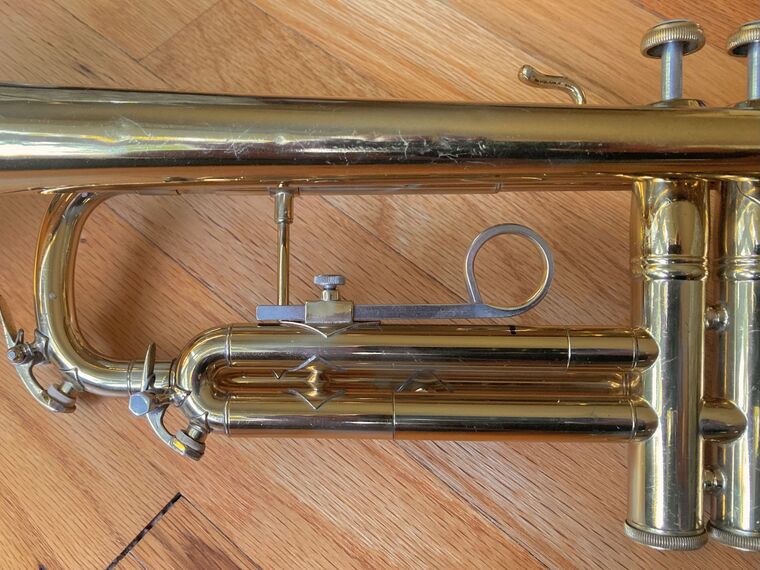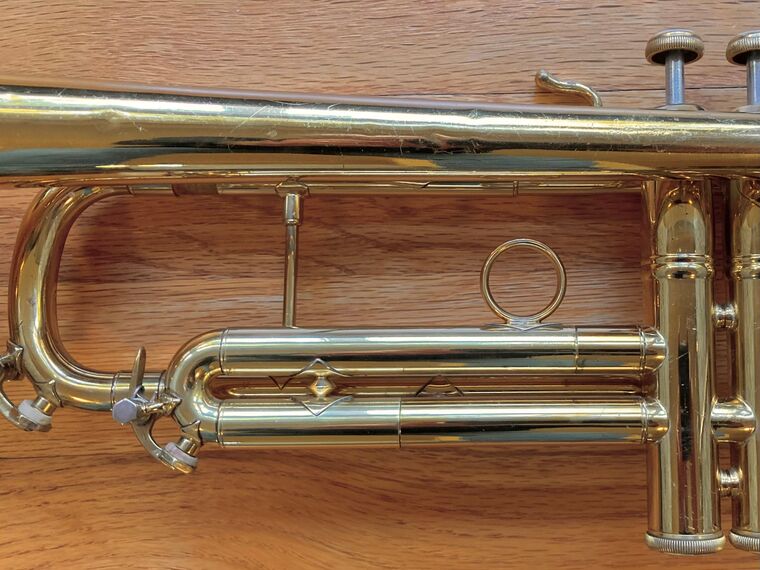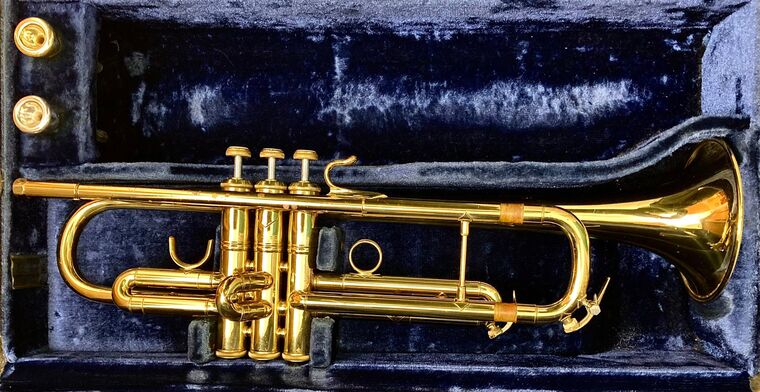Goodbye adjustable finger ring
-
I recently bought a 1976 Bach Mercedes trumpet, and love everything about it except for the awkward 3rd slide ring. To keep the all brass (no nickel) vibe of the horn, I started searching for an all-brass fixed ring, and found out that was a real project. I finally found an old slide from a Sears Silvertone with a brass ring on it and bought it. A trip to Southeastern Musical Services and about a week later I had the horn back, the fixed ring is in the same spot as my Stradivarius, and my finger is happy again…lol.


-
I have had a few horns with those adjustable rings. I think they existed so that somebody could have one of those things that holds marching band music.....I forget what it's called. But yeah, they are annoying.
-
These adjustable rings came into favour on instruments that students would use.
They were generally missing on professional standard horns.
The reason for their existence was that as the student grows into adulthood the smaller child sized hands grow in size and the fingers reach further. A fixed ring can then be awkward for the student.
Students need the ring position to be conveniently adjustable and the adjustable ring allows this.
The adjustment to the ring position can be made easily so that the ring is always a comfortable distance from the valve block for the player no matter how large their hands and how long their fingers.
When they finish growing a fixed ring becomes convenient.
The Lyre holder is a different thing altogether.
Typically I see Lyre holders fitted as standard on cornets and not fitted at all on trumpets. The marching instrument was typically a cornet in Europe.
Trumpet players of course also marched with trumpets and to facilitate fitting a Lyre to a trumpet a Lyre with a clamp was developed. The Lyre then could be fitted onto any convenient tube.
I have always found that the clamp on the adjustable finger ring would loosen at inconvenient times so the fixed ring makes a lot of sense for a serious player.
On the other hand many players dont like or use the ring to adjust intonation.
Looking at images of players like Miles Davis I see that on some images he reversed the position of the ring so that the ring was positioned way beyond reach of his fingers. This got rid of it entirely during that session.
Some players inverted the third slide when the legs on the third slide were the of equal length so that the ring hung beneath the slide. An example of an instrument that allows this is the Olds Ambassador which has legs of equal length and an adjustable ring. This instrument allows three options for getting rid of the ring entirely.
1 is to keep the adjustable ring but reverse it so the ring is extended completely beyond the slide
2 is to remove it and leave it in the case.
3 is to invert the third slide so the ring is under the slide.Some instruments of course were narrow wrap instruments which were built with ring hanging down.
The narrow wrap Selmer with underslung ring that Sachmo played which I believe was one of the Selmer Paris Grand Prix models was an example of this as is the Conn 58B.
This is what I have seen.
-
So if I buy a horn with a fixed ring and the ring is in the wrong position for my hand, I have to get it moved. Then over time I change my mind and have to get it moved again. And on and on it goes. I vote for adjustable rings. Or even better, give me a trigger. I've never liked rings anyway. Changing from gripping to extending seems wrong. Gripping and gripping a little harder seems more intuitive. I'm going to go play my York Eminence cornet now with a main tuning slide trigger and enjoy the obviously better design.
-
The adjustable ring is yet another reason why student instruments do not respond as well as more "professional" ones. Play a series of octave slurs at medium loudness (especially second line G to top of stave) and you will notice a HUGE difference with and without the adjustable ring.
I have NEVER had a student that needed a ring in a different position. In the beginning the pinky goes in the ring and during puberty (when the third slide becomes more important) the ring finger. If the third slide is well maintained, both fingers work well enough!
While we are at it, we teachers have to insure that the valves are not held with a "grip of death", rather just squeezing enough for stability. This also improves response dramatically! -
@ROWUK said in Goodbye adjustable finger ring:
The adjustable ring is yet another reason why student instruments do not respond as well as more "professional" ones. Play a series of octave slurs at medium loudness (especially second line G to top of stave) and you will notice a HUGE difference with and without the adjustable ring.
I have NEVER had a student that needed a ring in a different position. In the beginning the pinky goes in the ring and during puberty (when the third slide becomes more important) the ring finger. If the third slide is well maintained, both fingers work well enough!
While we are at it, we teachers have to insure that the valves are not held with a "grip of death", rather just squeezing enough for stability. This also improves response dramatically!YES! Since the adjustable ring was awkward to use because of its height and slight looseness in the holder, I took it out of the bracket and put it aside (plus, I could use the 1st valve slide saddle for the typical valve combinations that are a bit sharp). I immediately noticed that the old Bach played better, which I wasn’t expecting. That led to the decision to get rid of that entire heavy assembly and have a fixed rind installed.
-
@Richard-III said in Goodbye adjustable finger ring:
So if I buy a horn with a fixed ring and the ring is in the wrong position for my hand, I have to get it moved. Then over time I change my mind and have to get it moved again. And on and on it goes. I vote for adjustable rings. Or even better, give me a trigger. I've never liked rings anyway. Changing from gripping to extending seems wrong. Gripping and gripping a little harder seems more intuitive. I'm going to go play my York Eminence cornet now with a main tuning slide trigger and enjoy the obviously better design.
I see what you’re saying, but the older Bach Mercedes model was built mainly from Stradivarius parts, and I also have a Stradivarius that I’ve played for about 40 years. I had the shop install the fixed ring in exactly the same spot as it is on my Strad, so I think I’ll be happy with it.
 Here’s the Mercedes…
Here’s the Mercedes…
-
@Richard-III I am not sure that we should move things so quickly. The human state for the most part is infinitely adaptable and there are A LOT OF PLAYERS young and old that play stock Bach Strads or Yamaha Xenos without mods.
-
@ROWUK said in Goodbye adjustable finger ring:
@Richard-III I am not sure that we should move things so quickly. The human state for the most part is infinitely adaptable and there are A LOT OF PLAYERS young and old that play stock Bach Strads or Yamaha Xenos without mods.
I will admit that I mainly play vintage horns without rings, hooks or any device in the way. So much more comfortable. When I grip my old Conn 80A, it is like coming home and putting on my favorite slippers. It is a combination of wide space and no device in the way. Plus the slightly closer valve block to face intimacy that cornets provide just makes life better.
-
Freedom abounds with the Martin Committee. No ring needed. With its greasy ability for slotting, the third ring is obsolete. Check out the many pictures of Miles and Botti. You will note an absence of the third slide ring.
-
@Dale-Proctor The Bach Mercedes is a really good instrument, and those old Mercedes models (from the 1970s and earlier) play just as well as the "professional model" Bach Stradivarius models do (in my opinion, at least.) The same is true with the vintage so-called "student model" trumpets made by American companies (and made in America) in the 1970s and earlier. (The time frame varies from company to company, depending on exactly when each instrument manufacturing company began to change their "student models" and/or when each particular instrument company's quality started to deteriorate. Looks like you found a great solution for your 3rd slide ring dilemma though, so that's great!
-
@Dr-GO said in Goodbye adjustable finger ring:
Freedom abounds with the Martin Committee. No ring needed. With its greasy ability for slotting, the third ring is obsolete. Check out the many pictures of Miles and Botti. You will note an absence of the third slide ring.
Maybe in a Jazz setting, but NEVER in a classical setting. Those centered, resonant low C# and Ds simply need to fit in the section sound and that does not work without mechanical adjustment.
-
@ROWUK said in Goodbye adjustable finger ring:
@Dr-GO said in Goodbye adjustable finger ring:
Freedom abounds with the Martin Committee. No ring needed. With its greasy ability for slotting, the third ring is obsolete. Check out the many pictures of Miles and Botti. You will note an absence of the third slide ring.
Maybe in a Jazz setting, but NEVER in a classical setting. Those centered, resonant low C# and Ds simply need to fit in the section sound and that does not work without mechanical adjustment.
Have you ever tried a Martin Committee? It resonates all C# and Ds.
-
Love Retro mod horns. Comfort is my biggest motivation. If it makes it easier to play I am all for it.
Although I now only play modern horns, have in the past modified several horns. Did not hurt resale price at all.
Owners horn can do whatever they want with it.